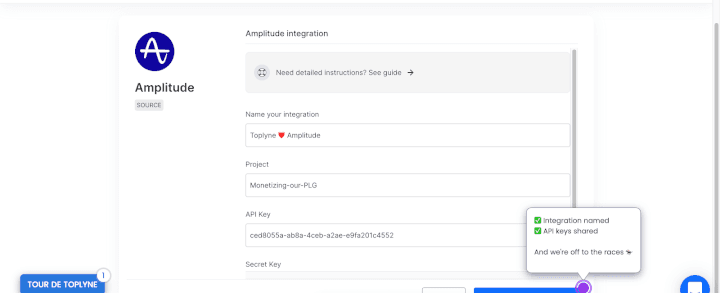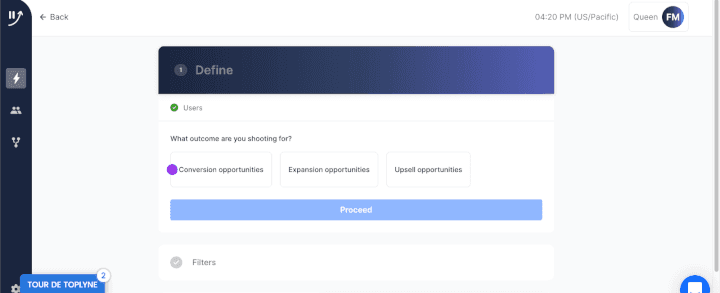5 No-Nonsense Tips for B2B Product-Led Growth
5 No-Nonsense Tips for B2B Product-Led Growth
5 No-Nonsense Tips for B2B Product-Led Growth
Explore what B2B product-led growth is, including the five best practices that can help you implement a killer B2B product-led growth strategy.
Explore what B2B product-led growth is, including the five best practices that can help you implement a killer B2B product-led growth strategy.
Explore what B2B product-led growth is, including the five best practices that can help you implement a killer B2B product-led growth strategy.



B2B product-led growth (PLG) is a business model where the product takes center stage.
So, if your product could speak…

PLG relies on the product to speak for itself to attract potential buyers.
In this article, we’ll discover what B2B product-led growth is. We’ll also highlight the five fundamental best practices to help you implement a successful B2B product-led growth strategy.
Let’s go!
What is B2B Product-Led Growth?
B2B product-led growth (PLG) is a business framework where the product is meant to be used and “sell itself” without the intervention of your sales team.
Modern businesses prefer experiencing the product they’re paying for first-hand. This can help B2B companies explore the reliability and appropriateness of the SaaS product on their own terms.
Additionally, the PLG model can boost your business’s credibility since users may share their customer success stories with others in the industry.
These referrals are a real game-changer for any B2B SaaS company since most B2B buyers are experts and won’t rely solely on the advice of a sales rep.
However, the market is brimming with endless products vying for your target user’s attention. So your potential buyer could be comparing your product’s value against several tools.
This makes B2B PLG a more challenging playing field.
So how do you step up your game as the product manager?
By devising a powerful B2B product-led growth strategy!
But building a unique growth marketing strategy entails a lot of brainstorming, stressing, and nail-biting….

Or not so much if you stay with us. 😉
Keep scrolling down to discover five kickass tips that can help you execute the perfect B2B product-led growth strategy.
5 Key Best Practices for an Effective B2B Product-Led Growth Strategy
Here are the five crucial tips to keep in mind to develop a profitable B2B PLG strategy:
1. Ensure Hassle-Free User Experience
You can trust B2B companies to know exactly what they need.
They want to see the value in your product quickly and have zero tolerance for clunky software that may ruin the user experience.
If your SaaS product is too complicated for B2B buyers to navigate, they won’t think twice before moving on.
After all, your product isn't irreplaceable like your granny’s cheesecake! The customer is always comparing you against another SaaS company offering products in the same price range.
Metrics like customer acquisition, user retention, and business expansion are solely determined by the product experience in a B2B SaaS company.
So the idea is to get them hooked on your product and deliver a customer experience that keeps them coming back for more!

2. Offer Multiple Pricing Options
Great, you’ve got users who’ve fallen in love with your product through the PLG approach.
But… they’ve hit the paywall, and now they have cold feet:

Pricing in a B2B product-led company can go wrong in many ways.
If your product’s pricing plans are too cheap, you won’t make enough. Make it too expensive and - you guessed it - they won’t buy it.🤦
Your buyer could be a small cost-sensitive startup or a large enterprise. They each have a unique budget based on their feature needs and team size.
As a result, you should experiment with several pricing options for your current users in the product-led growth strategy. It’ll allow them to choose a pricing plan that suits them – this may even give them that extra push to turn into paid users.
Here are a couple of pricing options that you can try out to improve user acquisition:
Free trial: Give users the entire product experience for a limited time.
Freemium pricing models: Let users test the product indefinitely, with some restrictions (reduced features, limited usage capacity, etc.)
Remember, everyone loves free stuff. 😋
A third option to elevate the customer experience in a product-led growth model even further is usage-based pricing.
What’s usage-based pricing?
This flexible pricing option in the product-led growth model lets users pay only for the features and services they need. It can give users a clear idea of the budget they need to realize additional value.
3. Identify Key Product-Led Growth Metrics
Growth metrics are quantitative indicators of the success of your B2B product-led growth company. It gives your potential investors an estimate of the business’s financial performance and the product team an idea of how useful B2B buyers find the product.
As a product-led company, you can modify your growth marketing strategy based on these metrics to improve the customer journey.
Here are the product-led growth metrics you should be tracking (like yesterday!):
Time to value (TTV): It measures the time it takes new users to realize your product’s value. The shorter the TTV, the better your user acquisition rate.
Average revenue per user (ARPU): It calculates the revenue earned from product usage and how much each customer contributes to your organization’s profits (and your annual bonus! 😅)
Customer lifetime value (CLV): This metric predicts how much revenue your business will get from a single customer in a lifetime.
Product-qualified leads (PQLs): It measures the number of activated users who’ve loved your product since the free or freemium trial.
Net churn: It’s the net percentage of total monthly recurring revenue lost from the existing customer base. It’s basically a wake up call for B2B SaaS companies to pull up their socks and approach product marketing differently.

Why track these metrics under the PLG strategy?
For instance, the number of referrals tells you what percentage of users successfully convinced other users to try out your product based on their positive customer feedback.
You can then check what pricing plan these users opted for, how long they used the product, and more. Basically, what factors turned your potential customer into a loyal advocate.
This will allow any product led growth company to duplicate success in other client relationships and implement a well-rounded product strategy that works!
4. Create the Best Impression With Entry Sales
Some B2B transactions could potentially be worth millions of dollars and usually consist of long-term relationships. As a result, you need to get B2B buyers to trust your product.
And an entry sale provides that opportunity in the B2B PLG model.
But what exactly is an entry sale?
It’s all about getting B2B SaaS companies to experience the product directly. The entry sale is steered by the product rather than any salesperson.
Get all the deets about product led sales for frictionless customer onboarding.
The product management team takes over, helping you deliver experiences that win over customers quickly. This way, you eliminate the step where your sales team has to make tons of cold calls.
Remember, people don’t buy products, they buy experiences.
And the goal of your product-led growth strategy is to solve a pain point and take them from ‘ugh!’ to ‘yayyy!’
These pain points may include outdated processes that affect productivity, lack of automation in workflows, or paying for overpriced features.
Think of yourself as the superhero with a secret weapon (your B2B product) that can save buyers from their pain points.
Once your product team develops a product that addresses all your customers’ concerns, you can swoop in with a spectacular entry sale!

Yep, that’s the entrance we’re talking about.
5. Encourage Experiments and Innovation
Product led growth teams at a B2B SaaS company develop business strategies based on experiments like:
Rolling out customer feedback forms to assess customer journey.
Incorporating social share buttons on website blogs that highlight your product’s robust features.
Using Google Analytics to track specific user actions and develop product marketing strategies based on that data.
Creating product usage personas and targeting different personas with different in-app prompts.
As a product manager, automating these processes can save your time and your employees’ sanity. After all, going digital and paperless is way better than going hairless. 😅
And that’s where Toplyne comes in.
Toplyne is a SaaS platform that lets growth teams at any PLG company rapidly experiment and deploy various go-to-market (GTM) motions at scale.
Experiment with various conversion strategies to execute your preferred go-to-market strategy. Choose from remarketing, automated messaging, sales-assist motions, and even in-product nudges.

And the experiments don’t have to stop there!
Toplyne can also help you in:
Automation: Automates the process of identifying promising leads and figuring out what go-to-market strategies will work best for each potential customer.
Personalization: Craft in-product tailored experiences that encourage users to invite more team members and implement a powerful customer success strategy.

Integrations: Integrates with popular CRM tools (Salesforce, Hubspot), customer engagement platforms (Braze), and product analytics infrastructures (Amplitude, Segment).

Evaluation: Helps you define the growth strategy and choose the target outcome for your user base.

In fact, world-class SaaS companies like Canva, Invideo, and Grafana Labs have already monetized their product led growth and improved customer acquisition using Toplyne!
Amp Up Your Sales With A B2B Product-Led Growth Strategy
There’s no doubt that sales-led growth and marketing led growth are relics of the past. The future is product led growth!
So go through the best practices we’ve listed here to create a killer B2B product-led growth strategy.
And make sure you knock out competitors by choosing a platform like Toplyne.
It can help your growth team hunt down high intent users that are most likely to convert to paying customers!
Ready to make a winning move with a product-led approach?
Sign up for Toplyne for free today!

B2B product-led growth (PLG) is a business model where the product takes center stage.
So, if your product could speak…

PLG relies on the product to speak for itself to attract potential buyers.
In this article, we’ll discover what B2B product-led growth is. We’ll also highlight the five fundamental best practices to help you implement a successful B2B product-led growth strategy.
Let’s go!
What is B2B Product-Led Growth?
B2B product-led growth (PLG) is a business framework where the product is meant to be used and “sell itself” without the intervention of your sales team.
Modern businesses prefer experiencing the product they’re paying for first-hand. This can help B2B companies explore the reliability and appropriateness of the SaaS product on their own terms.
Additionally, the PLG model can boost your business’s credibility since users may share their customer success stories with others in the industry.
These referrals are a real game-changer for any B2B SaaS company since most B2B buyers are experts and won’t rely solely on the advice of a sales rep.
However, the market is brimming with endless products vying for your target user’s attention. So your potential buyer could be comparing your product’s value against several tools.
This makes B2B PLG a more challenging playing field.
So how do you step up your game as the product manager?
By devising a powerful B2B product-led growth strategy!
But building a unique growth marketing strategy entails a lot of brainstorming, stressing, and nail-biting….

Or not so much if you stay with us. 😉
Keep scrolling down to discover five kickass tips that can help you execute the perfect B2B product-led growth strategy.
5 Key Best Practices for an Effective B2B Product-Led Growth Strategy
Here are the five crucial tips to keep in mind to develop a profitable B2B PLG strategy:
1. Ensure Hassle-Free User Experience
You can trust B2B companies to know exactly what they need.
They want to see the value in your product quickly and have zero tolerance for clunky software that may ruin the user experience.
If your SaaS product is too complicated for B2B buyers to navigate, they won’t think twice before moving on.
After all, your product isn't irreplaceable like your granny’s cheesecake! The customer is always comparing you against another SaaS company offering products in the same price range.
Metrics like customer acquisition, user retention, and business expansion are solely determined by the product experience in a B2B SaaS company.
So the idea is to get them hooked on your product and deliver a customer experience that keeps them coming back for more!

2. Offer Multiple Pricing Options
Great, you’ve got users who’ve fallen in love with your product through the PLG approach.
But… they’ve hit the paywall, and now they have cold feet:

Pricing in a B2B product-led company can go wrong in many ways.
If your product’s pricing plans are too cheap, you won’t make enough. Make it too expensive and - you guessed it - they won’t buy it.🤦
Your buyer could be a small cost-sensitive startup or a large enterprise. They each have a unique budget based on their feature needs and team size.
As a result, you should experiment with several pricing options for your current users in the product-led growth strategy. It’ll allow them to choose a pricing plan that suits them – this may even give them that extra push to turn into paid users.
Here are a couple of pricing options that you can try out to improve user acquisition:
Free trial: Give users the entire product experience for a limited time.
Freemium pricing models: Let users test the product indefinitely, with some restrictions (reduced features, limited usage capacity, etc.)
Remember, everyone loves free stuff. 😋
A third option to elevate the customer experience in a product-led growth model even further is usage-based pricing.
What’s usage-based pricing?
This flexible pricing option in the product-led growth model lets users pay only for the features and services they need. It can give users a clear idea of the budget they need to realize additional value.
3. Identify Key Product-Led Growth Metrics
Growth metrics are quantitative indicators of the success of your B2B product-led growth company. It gives your potential investors an estimate of the business’s financial performance and the product team an idea of how useful B2B buyers find the product.
As a product-led company, you can modify your growth marketing strategy based on these metrics to improve the customer journey.
Here are the product-led growth metrics you should be tracking (like yesterday!):
Time to value (TTV): It measures the time it takes new users to realize your product’s value. The shorter the TTV, the better your user acquisition rate.
Average revenue per user (ARPU): It calculates the revenue earned from product usage and how much each customer contributes to your organization’s profits (and your annual bonus! 😅)
Customer lifetime value (CLV): This metric predicts how much revenue your business will get from a single customer in a lifetime.
Product-qualified leads (PQLs): It measures the number of activated users who’ve loved your product since the free or freemium trial.
Net churn: It’s the net percentage of total monthly recurring revenue lost from the existing customer base. It’s basically a wake up call for B2B SaaS companies to pull up their socks and approach product marketing differently.

Why track these metrics under the PLG strategy?
For instance, the number of referrals tells you what percentage of users successfully convinced other users to try out your product based on their positive customer feedback.
You can then check what pricing plan these users opted for, how long they used the product, and more. Basically, what factors turned your potential customer into a loyal advocate.
This will allow any product led growth company to duplicate success in other client relationships and implement a well-rounded product strategy that works!
4. Create the Best Impression With Entry Sales
Some B2B transactions could potentially be worth millions of dollars and usually consist of long-term relationships. As a result, you need to get B2B buyers to trust your product.
And an entry sale provides that opportunity in the B2B PLG model.
But what exactly is an entry sale?
It’s all about getting B2B SaaS companies to experience the product directly. The entry sale is steered by the product rather than any salesperson.
Get all the deets about product led sales for frictionless customer onboarding.
The product management team takes over, helping you deliver experiences that win over customers quickly. This way, you eliminate the step where your sales team has to make tons of cold calls.
Remember, people don’t buy products, they buy experiences.
And the goal of your product-led growth strategy is to solve a pain point and take them from ‘ugh!’ to ‘yayyy!’
These pain points may include outdated processes that affect productivity, lack of automation in workflows, or paying for overpriced features.
Think of yourself as the superhero with a secret weapon (your B2B product) that can save buyers from their pain points.
Once your product team develops a product that addresses all your customers’ concerns, you can swoop in with a spectacular entry sale!

Yep, that’s the entrance we’re talking about.
5. Encourage Experiments and Innovation
Product led growth teams at a B2B SaaS company develop business strategies based on experiments like:
Rolling out customer feedback forms to assess customer journey.
Incorporating social share buttons on website blogs that highlight your product’s robust features.
Using Google Analytics to track specific user actions and develop product marketing strategies based on that data.
Creating product usage personas and targeting different personas with different in-app prompts.
As a product manager, automating these processes can save your time and your employees’ sanity. After all, going digital and paperless is way better than going hairless. 😅
And that’s where Toplyne comes in.
Toplyne is a SaaS platform that lets growth teams at any PLG company rapidly experiment and deploy various go-to-market (GTM) motions at scale.
Experiment with various conversion strategies to execute your preferred go-to-market strategy. Choose from remarketing, automated messaging, sales-assist motions, and even in-product nudges.

And the experiments don’t have to stop there!
Toplyne can also help you in:
Automation: Automates the process of identifying promising leads and figuring out what go-to-market strategies will work best for each potential customer.
Personalization: Craft in-product tailored experiences that encourage users to invite more team members and implement a powerful customer success strategy.

Integrations: Integrates with popular CRM tools (Salesforce, Hubspot), customer engagement platforms (Braze), and product analytics infrastructures (Amplitude, Segment).

Evaluation: Helps you define the growth strategy and choose the target outcome for your user base.

In fact, world-class SaaS companies like Canva, Invideo, and Grafana Labs have already monetized their product led growth and improved customer acquisition using Toplyne!
Amp Up Your Sales With A B2B Product-Led Growth Strategy
There’s no doubt that sales-led growth and marketing led growth are relics of the past. The future is product led growth!
So go through the best practices we’ve listed here to create a killer B2B product-led growth strategy.
And make sure you knock out competitors by choosing a platform like Toplyne.
It can help your growth team hunt down high intent users that are most likely to convert to paying customers!
Ready to make a winning move with a product-led approach?
Sign up for Toplyne for free today!

Related Articles




Behavioral Retargeting: A Game-Changer in the Cookieless Era
Unlock the power of behavioral retargeting for the cookieless future! Learn how it personalizes ads & boosts conversions. #behavioralretargeting




All of Toplyne's 40+ Badges in the G2 Spring Reports
Our customers awarded us 40+ badges in G2's Summer Report 2024.




Unlocking the Full Potential of Google PMax Campaigns: Mastering Audience Selection to Double Your ROAS
Copyright © Toplyne Labs PTE Ltd. 2024
Copyright © Toplyne Labs PTE Ltd. 2024
Copyright © Toplyne Labs PTE Ltd. 2024
Copyright © Toplyne Labs PTE Ltd. 2024